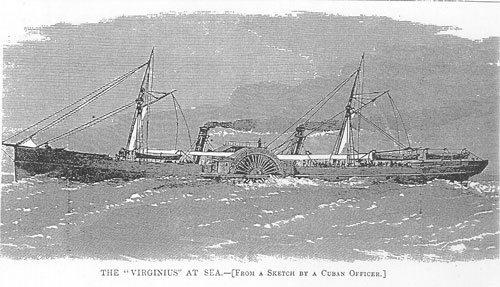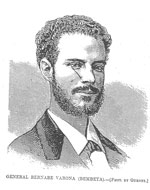
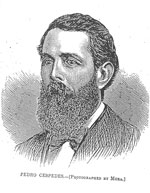
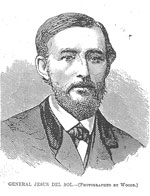
(Photos from Harper's Weekly, Saturday, November 29, 1873)
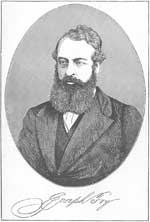
(photo courtesy of W. Hatfield, his GGGGrandson)
The Virginius Incident
|
|
|
The ShipThe Virgin was constructed for the Confederate Navy at a Scottish shipyard on the Clyde in 1864 and was intended expressly for blocade running. The ship was a sidewheel steamer over 200 feet (61m) long, 10 feet (3m) from the waterline to the deck and a displacement of 491 tons (445 metric tonnes) and capable of remarkable speed due to its powerful engines. It made several trips between Habana and Mobile, through the blocade, before capture ladden with cotton, by Union forces at Mobile. For the next five years, ownership passed back and forth between the United States and private shipping interests until it was sold in 1870 to one John F. Patterson, an agent of General Manuel Quesada and the Cuban Junta of New York. Patterson and his colleagues had the vessel overhauled and re-registered the ship under the name Virginius. The Virginius sailed from New York on 4 October 1870, and during the next two years was used to transport arms and men to aid the insurgencies against Spain in Cuba and Venezuela. During this time the Spaniards became well aware of the ship and its mission. It narrowly escaped capture by the Spaniards at Aspinwall, Colombia (the present day city of Colon in Panama) and was only saved by the presence of a US naval vessel which protected the ship (which was flying the US flag). The ship was regarded by Spain as a pirate ship and had several other narrow escapes.
CaptureOn 23 October 1873, the Virginius sailed from Kingston, Jamaica with a large number of Cuban insurgents (102 according to our count). The ship sailed to Jeremie on the island of Haiti and from there to Port-au-Prince, where 300 Remingtons and 300,000 cartridges were loaded on-board. From Port-au-Prince the Virginius went to Comito, where 800 daggers, 800 machetes, a barrel of powder and a case of shoes was loaded. The steamer, which at this time was leaking, headed for Cuba, but never reached shore. About six miles from land, with the hills of Guantanamo in sight, the Virginius was intercepted by the Spanish warship Tornado, under the command of Captain Dionisio Costilla (the Tornado, coincidentally had been built at the same Scottish shipyard for the Chilean navy and had been captured by a Spanish frigate during the Pacific War between Chile and Peru and incoporated into the Spanish Armada under the same name) . The Virginius then turned course to Jamaica and an 8-hour sea chase ensued. During this chase, guns and equipment were dumped overboard to lighten ship, but the poor physical condition of the ship and engines caused Captain Fry to stop and surrender the ship barely 6 miles from the Jamaican coast on 31 October 1873 (some reports indicate that the ship was already within British territorial waters). The Virginius was towed by the Tornado to Santiago de Cuba harbor and arrived on 1 November 1873. On board were a total of 165 persons (154 according to our count), including the ship's crew and an expeditionary force intending to aid the Cuban revolutionary cause. Ship's CrewThe Crew of the Virginius consisted of the following individuals (mostly US citizens or British subjects):
Expeditionary ForcesThe expeditionary passengers on board the Virginius were the following:
High Ranking Officers of the Army of Liberation
Other Members of the Expeditionary Force (in alphabetical order by surname)
Trials and First ExecutionsUnder pressure from the directors of the pro-Spain "Circulo Español" and "Club San Carlos" and officers of the Spanish "Volunteers" (a pro-Spain semi-official corps, somewhat like a National Guard, with a reputation for cruelty), a verbal Council of War was immediately held in the Dolores fortress on 2 November 1873 on orders from the Spanish Military Commander of Santiago, General Juan Nepomuceno Burriel. This Council sentenced the leaders of the expedition to be immediately executed. The four ranking officers of the Army of Liberation were executed at 6AM on 4 November 1873:
A court-martial was held on 7 Nov 1873 on board the warship San Francisco de Borja, under the presidency of the ship's captain, Frigate Captain Narciso Fernandez Pedruñan. This court-martial on 8 Nov 1873 by unanimous vote, condemned the Captain and 36 members of the ship's crew to be executed by being shot in the back by a firing squad. The crewmembers named below were executed by firing squad at 4PM of the same day:
The following crewmembers were sentenced to life imprisonment by a plurality of votes of the tribunal:
The following crewmembers were sentenced to 8 years in prison:
The following crewmembers were sentenced to 4 years in prison:
The following crewmembers were freed by unanimous vote of the tribunal:
More ExecutionsAn addendum to the first order was issued by Antonio Fernandez, Naval Commander, on the same day, 7 November 1873, condemning an additional twelve Cuban revolutionaries to be executed the next day . The following individuals were executed by firing squad at 6AM on 8 November 1873:
On a related note, Eliseo Matinez Corder, a poet and newspaper reporter, editor of El Diario de Santiago de Cuba, was sentenced to prison for having published that Herminio Quesada and Arturo Loret de Mola were both minors, under the age of 14.
Diplomatic EffortsThe Consuls of Great Britain and the United States formulated claims over the proceedings. These were ignored by Commanding General Burriel. (more details to be added) Sir. Lambton LoraineNews of the capture of the Virginius and the immediate executions reached Kingston via a clandestine message sent by a Cuban employee of the British Cable agency in Santiago de Cuba. These news acquired some importance since it was suspected that some members of the ship's crew and expeditionary force were British Subjects and that the capture might have taken place within British territorial waters. At 11AM [1PM] on 8 November 1873 the British warship Niobe, under the command of Sir Lambton Loraine arrived in Santiago de Cuba harbor from Kingston. Commander Loraine immediately sent the following communique to Burriel:
Sir Lambton Loraine delivered the letter personally and did not leave the office of the Military Governor until he received a satisfactory reply. Burriel had decided, in order for the punishment to be more exemplary, that all individuals would not be executed on the same day, but only a few each day. The city thus was subject for several days to the sound of the discharges from the executions, followed by church bells tolling. The valiant intervention of Lorraine stopped the executions cold and thus many cubans, americans and britons were saved by his action. Once the promise from the Governor to stop executions was obtained, Loraine departed the Governor's Palace. At the door of the palace when he was leaving, he nodded his head at the Spanish Military Governor, who extended his hand in greeting. The British Commander did not touch the extended hand and told the interpreter, Isidoro P. Agostini y Cortes: " Tell him I do not shake hands with assassins". "What did he say?" asked the Governor. The interpreter replied "he speaks of unimportant matters". MemorialsThe Santiago de Cuba municipality, after Cuba obtained its freedom, designated the wide street that runs parallel to the piers as "Lambton Loraine" street. At the center of the street, in front of the cutoms house, there was a bronze bust of the unforgettable British Captain. The present government of Cuba unfortunately has changed the name of this street to memorialize a communist leader. We do not know if the bronze bust is still there. In the Santa Efigenia cemetery of Santiago de Cuba there is a small rectangular pantheon, with a royal palm in each of its corners, where the victims of the Virginius are buried. There is a plaque in memory of the victims.
Departure of the VirginiusOn 12 November [12 December] 1873, the Virginius, escolted by the spanish warships Tornado and Isabel la Catolica, left Santiago harbor. As a result of a diplomatic agreement between the governments of the United States and Spain, the Virginius was moved to the harbor at Bahia Honda, where it was delivered to the USS Despatch, commanded by Lieutenant Commander Rodgers on Tuesday 18 December 1873. Due to the poor condition of the ship, the Despatch had to tow the Virginius towards Dry Tortugas, Florida, with New York being the intended final destination. Due to increasing water leaks, failure of the boilers which stopped operation of the pumps, and rapidly deteriorating weather conditions, the Virginius foundered and sank at 4:17PM on 26 December 1873 in Atlantic waters off Cape Hatteras. One of our readers informs us that the Virginius sank near Cape Fear, North Carolina (not Cape Hatteras which is several hundred miles north) and the ship rests on the ocean bottom very near Oak Island, N.C.9.
SurvivorsOn 3 Dec 1873, a group of survivors from the Virginius were delivered to Sir Lampton Loraine, commander of the British warship Niobe (the number and identity of these survivors is not documented in any of the references).On 18 Dec 1873, in front of the Morro fortress, the remaining survivors from the Virginius were delivered to Commander Braine of the US corvette warship Juniata. All survivors, regardless of citizenship, elected to go to New York aboard the Juniata. There the men were turned over to the care of Los Amigos de Cuba until provision could be made for sending them to their various homes. Stories began to appear that the Junta has given an ungenerous welcome to the men. Among charges and countercharges, the survivors of the Virginius dropped from sight and from the pages of history.
References:
AcknowledgementThe Webmaster is extremely grateful to Humberto Estrada del Sol, of Dallas, Texas, for sharing the interest in this incident and for supplying copies of the first five above listed references. Personal NoteI first learned about this incident in an end note in my uncle Felipito Silva's personal memoires. We were never taught about this event in my grammar school history classes in Cuba, although a great deal of time was spent (and conmmemorative radio documentaries were even aired every year) on the incident concerning the eight students executed by the Spanish Government on 27 November 1871 (two years earlier), a date which is conmemorated annually in Cuba as an official Day of Mourning..
|
|
|
Virginius Incident - Updated
17-Oct-2012
Copyright © 2007-2015 - Ed Elizondo
|
|

